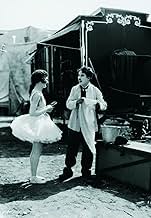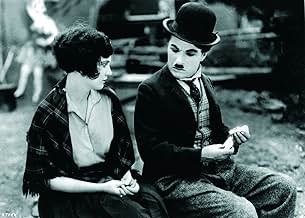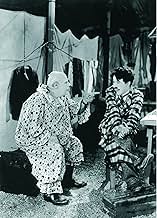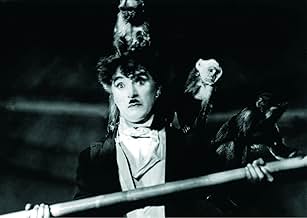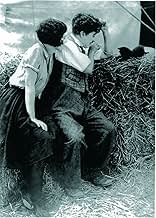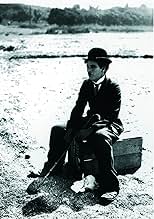IMDb RATING
8.1/10
38K
YOUR RATING
The Tramp finds work and the girl of his dreams at a circus.The Tramp finds work and the girl of his dreams at a circus.The Tramp finds work and the girl of his dreams at a circus.
- Awards
- 3 wins total
Charles Chaplin
- A Tramp
- (as Charlie Chaplin)
Al Ernest Garcia
- The Circus Proprietor and Ring Master
- (as Allan Garcia)
Tiny Sandford
- The Head Property Man
- (as Stanley J. Sandford)
Albert Austin
- Clown
- (uncredited)
Chester A. Bachman
- Cop
- (uncredited)
Eugene Barry
- Cop
- (uncredited)
Jack Bernard
- Man in Circus Audience
- (uncredited)
Stanley Blystone
- Cop
- (uncredited)
Heinie Conklin
- Clown
- (uncredited)
Toraichi Kono
- Man in Circus Audience
- (unconfirmed)
- (uncredited)
H.L. Kyle
- Man in Circus Audience
- (uncredited)
Betty Morrissey
- The Vanishing Lady
- (uncredited)
- Director
- Writer
- All cast & crew
- Production, box office & more at IMDbPro
Featured reviews
The Circus was both my first silent film and the first film I've watched by Charles Chaplin. Being my first silent film i thought for sure i would be bored to death, but was i wrong. The film was really funny, made me laugh out loud. The comedy in this film is very different to the comedy in films now a days. Now a days most comedy films are big on the special effects and just lame humor. In the circus the actors have actual talent, they have to be very good at showing there emotion, like facial expressions and things like that.I was amazed on how well the movie was, Charlie Chaplin is great and i hope soon i can get my hands on some more of his films. I almost wish they could make a films like this today just maybe with some color, i think it'd be a great idea.
When Charlie Chaplin first plods onto screen in The Circus, he has his back to us. Unusual for any other leading man, but Chaplin was such a legendary icon, even now when he was only making one film every few years, his mere outline was enough to announce his presence. But with such a status came a certain weariness, and The Circus is one of a number of pictures in which Chaplin lampoons the whole process that made his name.
A lot of the business in The Circus is about Chaplin's ability to be naturally comical, and the shortcomings of being an employed comedian. It's interesting how, more than any Chaplin picture that came before or after, The Circus seems to be putting us (the audience) into the little tramp's experience. There are a number of point of view shots, and often characters addressing Charlie are virtually staring into the lens, as opposed to the profile shots he usually stuck to. Even the shots in the ring do not give us the perspective of the big top crowd, and instead the camera looks in on the action from the performers' entrance. The camera is always in the sawdust and never the stalls. This is, from its very first scene, clearly a backstage movie. It may seem a subtle shift but Chaplin is certainly drawing us more to focusing on the lives of circus folk and away from thinking of the circus as entertainment. It's notable too that Chaplin's best comedy vignettes occur outside the big top.
It seems Chaplin was increasingly giving larger and more substantial roles to his leading ladies. Oddly however, while Merna Kennedy plays the most fleshed-out female lead of any Chaplin picture to date, she seems less of a focus for the camera, which barely lingers on her. From what we can see she is not bad, but she lacks the calm dignity of Edna Purviance and Georgia Hale, or at least does not get to display such a thing. More reassuringly, there is a decent-sized part for Chaplin regular Henry Bergman as an old clown. Bergman had been a comedy performer for decades, and had even worked in a real circus in his youth, so he certainly knew what this role was about. With some heartfelt facial acting amongst all his usual huffing and puffing about, it is probably his finest performance.
If The Circus is known for anything, it tends to be the very fact that it is not as well known as many of Chaplin's other features. Chaplin himself does not even mention it in his autobiography (the imaginatively titled "My autobiography" – but then again, being the legend that he is, he doesn't need a punchy title to promote his own name). But far from neglecting the work, Chaplin gave it surely his neatest and most delicate update-job when he came to overhaul all his silent features for re-release in the 60s and 70s. Unlike The Kid and A Woman of Paris, from which he cut several scenes, and The Gold Rush, which he all but butchered in 1943, The Circus is left intact. He also treats it to its own theme song, under which the opening credits are inter-cut with shots of Kennedy on the trapeze, creating the most tender and lyrical opening of all his pictures.
A lot of the business in The Circus is about Chaplin's ability to be naturally comical, and the shortcomings of being an employed comedian. It's interesting how, more than any Chaplin picture that came before or after, The Circus seems to be putting us (the audience) into the little tramp's experience. There are a number of point of view shots, and often characters addressing Charlie are virtually staring into the lens, as opposed to the profile shots he usually stuck to. Even the shots in the ring do not give us the perspective of the big top crowd, and instead the camera looks in on the action from the performers' entrance. The camera is always in the sawdust and never the stalls. This is, from its very first scene, clearly a backstage movie. It may seem a subtle shift but Chaplin is certainly drawing us more to focusing on the lives of circus folk and away from thinking of the circus as entertainment. It's notable too that Chaplin's best comedy vignettes occur outside the big top.
It seems Chaplin was increasingly giving larger and more substantial roles to his leading ladies. Oddly however, while Merna Kennedy plays the most fleshed-out female lead of any Chaplin picture to date, she seems less of a focus for the camera, which barely lingers on her. From what we can see she is not bad, but she lacks the calm dignity of Edna Purviance and Georgia Hale, or at least does not get to display such a thing. More reassuringly, there is a decent-sized part for Chaplin regular Henry Bergman as an old clown. Bergman had been a comedy performer for decades, and had even worked in a real circus in his youth, so he certainly knew what this role was about. With some heartfelt facial acting amongst all his usual huffing and puffing about, it is probably his finest performance.
If The Circus is known for anything, it tends to be the very fact that it is not as well known as many of Chaplin's other features. Chaplin himself does not even mention it in his autobiography (the imaginatively titled "My autobiography" – but then again, being the legend that he is, he doesn't need a punchy title to promote his own name). But far from neglecting the work, Chaplin gave it surely his neatest and most delicate update-job when he came to overhaul all his silent features for re-release in the 60s and 70s. Unlike The Kid and A Woman of Paris, from which he cut several scenes, and The Gold Rush, which he all but butchered in 1943, The Circus is left intact. He also treats it to its own theme song, under which the opening credits are inter-cut with shots of Kennedy on the trapeze, creating the most tender and lyrical opening of all his pictures.
Although movie buffs seldom mention `The Circus' in the same breath as Charlie Chaplin's more touted masterpieces (`City Lights,' `Modern Times,' `The Gold Rush'), this film contains some of his best work manifested in a number of ingenious sequences. Chaplin once again dons the role of the tramp, this time having all sorts of adventures (and misadventures) under the big top.
In order to evade the police who suspect him of being a thief, the tramp ducks into a circus tent and acts as if he is part of the show. The cops follow him into the tent and try to apprehend him, with comical results. The crowd goes wild, believing all this was planned ahead of time. The audience's reaction is so strong that the tyrannical circus owner hires him on the spot. When it is discovered that Chaplin cannot be funny intentionally, the owner gives him a job as a prop man, clumsily lugging equipment around the tent as part of the show. Again the crowd roars its approval at his inadvertent antics, and soon the tramp is the circus' main attraction. In the meantime, he falls in love with the owner's daughter, a bareback rider who herself loves the tightrope walker, and romantic complications ensue.
`The Circus' is an all-around Chaplin effort. In addition to playing the lead role, he wrote, directed, produced and edited it, and composed the music as well. It is a meticulous production on all counts, with each sequence choreographed to elicit the maximum capacity of laughter from the audience. The scenes in which the tramp is pursued through a hall of mirrors, trapped inside the lion's cage, and forced to double for the missing tightrope walker stand alongside his finest achievements. The ending sequence is especially heartrending, as many are in his films. Here is a movie to be cherished by all fans of Chaplin, but appreciated even by casual viewers. This is because it achieves a rare blend of comedy and poignancy through appealing, sympathetic characters and with genuine honesty adding a note of realism to counterbalance the clowning.
In order to evade the police who suspect him of being a thief, the tramp ducks into a circus tent and acts as if he is part of the show. The cops follow him into the tent and try to apprehend him, with comical results. The crowd goes wild, believing all this was planned ahead of time. The audience's reaction is so strong that the tyrannical circus owner hires him on the spot. When it is discovered that Chaplin cannot be funny intentionally, the owner gives him a job as a prop man, clumsily lugging equipment around the tent as part of the show. Again the crowd roars its approval at his inadvertent antics, and soon the tramp is the circus' main attraction. In the meantime, he falls in love with the owner's daughter, a bareback rider who herself loves the tightrope walker, and romantic complications ensue.
`The Circus' is an all-around Chaplin effort. In addition to playing the lead role, he wrote, directed, produced and edited it, and composed the music as well. It is a meticulous production on all counts, with each sequence choreographed to elicit the maximum capacity of laughter from the audience. The scenes in which the tramp is pursued through a hall of mirrors, trapped inside the lion's cage, and forced to double for the missing tightrope walker stand alongside his finest achievements. The ending sequence is especially heartrending, as many are in his films. Here is a movie to be cherished by all fans of Chaplin, but appreciated even by casual viewers. This is because it achieves a rare blend of comedy and poignancy through appealing, sympathetic characters and with genuine honesty adding a note of realism to counterbalance the clowning.
10lugonian
THE CIRCUS (United Artists, 1928) written, produced, directed and starring Charlie Chaplin, is a well-documented gem about circus life, mixing comedy and sentiment in the best Chaplin tradition, ranking this one of his finer yet neglected achievements of the 1920s.
In it, Chaplin plays a tramp who drifts at the midway of the circus after being wrongly accused of a theft and chased by a policeman. His escapades are mistaken as part of the act, which stirs roars of laughter from its audience. Because his circus has not been earning any profits, the ringmaster/owner (Allan Garcia) decides in hiring Charlie as his top attraction. However it is learned that Charlie is only funny whenever he blunders to his viewing public. Charlie soon learns from the abused Merna (Merna Kennedy), how valuable he really is, thus, making demands of quitting to his employer unless he ceases mistreating his stepdaughter, and offers him a higher salary, which he does. All goes well until Rex (Henry Crocker), "King of the High Wire," joins the circus and becomes attracted to Merna, causing Charlie to vie for her affections any which way he can.
With the circus being one of the more famous backdrops of many movie comedians and/or comedy teams ranging from W.C. Fields to Laurel & Hardy, The Marx Brothers to Martin and Lewis, THE CIRCUS stands out more for its ingenious use of difficult gags, comic timing and the effort that went into it to make every gag funny as well as realistically done. Rarely seen since its original theatrical release, THE CIRCUS came into full view again shortly after Chaplin's death in 1977. Newly scored and restored by Chaplin himself in 1968 (as mentioned in the new opening titles), with his singing of "Swing Little Girl" recorded on the soundtrack during the opening credits, my first experience with THE CIRCUS was in 1980 at New York City's Regency Theater, 68th Street and Broadway, where the revival theater (which no longer exists, having been demolished in 1998) paid a tribute to Chaplin with a series of shorts and features, including THE KID (1921), MODERN TIMES (1936) and THE GREAT DICTATOR (1940). Being surrounded by an appreciative audience laughing at a silent film made long ago indicated d THE CIRCUS has stood the test of time and what a comic genius Chaplin was, especially when demonstrating how difficult performing comedy can be as his character finds he has to be funny and isn't, and at the same time showing how poor he is as a comic to the circus staff and how funny he is as a bad comedian to the movie audience. While sitting in the dark movie theater of all ages at the Regency, the biggest laughs occurred during the opening as Chaplin hides from the law inside a fun house surrounded by mirrors and later making a fool out of the rival pickpocket (Steve Murphy) as they each attempt to fool the policeman by pretending to be movable statues; Charlie's encounter with a lion while locked inside the cage; and the biggest topper of all being Charlie doing a tight rope wire act and trying to balance himself while loose monkeys crawl all over him, thus disrupting his act. These same gags obviously brought forth many laughs in 1980 as it did in 1928, and continue to do so today. In between these gags comes pathos, which Chaplin also succeeds without hurting the continuity.
Chaplin staff players regulars such as Harry Bergman as the Clown, and Stanley Sanford as the Head Property lead fine support. Others in the cast include Betty Morrissey as The Vanishing Lady; George Davis as The Magician; John Rand, Albert Austin and Heinie Conklin in smaller roles.
In spite of its true greatness, it's hard to believe how underrated THE CIRCUS has become, not having the appreciation as Chaplin's own masterpieces, THE GOLD RUSH (1925) and CITY LIGHTS (1931), even by Chaplin himself. It's been said that during the making of THE CIRCUS, Chaplin was going through personal problems of his own, including divorce and the passing of his mother. It's even more ironic the elimination of THE CIRCUS from Chaplin's own autobiography published in 1964 while his other works were profiled to great extent, regardless of his nomination as Best Actor and Best Comedy Director by the Academy for 1927-28 awards. At least this has been amended through its reissue throughout the years to a new generation of movie lovers.
Distributed onto video cassette as part of the Chaplin centennial collection in 1989, THE CIRCUS, currently on DVD, made its presence known on television in the height of cable television, notably on the weekly series, "Dead Comics Society" on the Comedy Channel hosted by Kevin Kline around 1989-90, followed by American Movie Classics (1997-2000) and Turner Classic Movies where it made its debut in 2003.
THE CIRCUS, a 70 minute comedy, is a fine study to film students and anyone appreciating and supporting the art of silent comedy. (****)
In it, Chaplin plays a tramp who drifts at the midway of the circus after being wrongly accused of a theft and chased by a policeman. His escapades are mistaken as part of the act, which stirs roars of laughter from its audience. Because his circus has not been earning any profits, the ringmaster/owner (Allan Garcia) decides in hiring Charlie as his top attraction. However it is learned that Charlie is only funny whenever he blunders to his viewing public. Charlie soon learns from the abused Merna (Merna Kennedy), how valuable he really is, thus, making demands of quitting to his employer unless he ceases mistreating his stepdaughter, and offers him a higher salary, which he does. All goes well until Rex (Henry Crocker), "King of the High Wire," joins the circus and becomes attracted to Merna, causing Charlie to vie for her affections any which way he can.
With the circus being one of the more famous backdrops of many movie comedians and/or comedy teams ranging from W.C. Fields to Laurel & Hardy, The Marx Brothers to Martin and Lewis, THE CIRCUS stands out more for its ingenious use of difficult gags, comic timing and the effort that went into it to make every gag funny as well as realistically done. Rarely seen since its original theatrical release, THE CIRCUS came into full view again shortly after Chaplin's death in 1977. Newly scored and restored by Chaplin himself in 1968 (as mentioned in the new opening titles), with his singing of "Swing Little Girl" recorded on the soundtrack during the opening credits, my first experience with THE CIRCUS was in 1980 at New York City's Regency Theater, 68th Street and Broadway, where the revival theater (which no longer exists, having been demolished in 1998) paid a tribute to Chaplin with a series of shorts and features, including THE KID (1921), MODERN TIMES (1936) and THE GREAT DICTATOR (1940). Being surrounded by an appreciative audience laughing at a silent film made long ago indicated d THE CIRCUS has stood the test of time and what a comic genius Chaplin was, especially when demonstrating how difficult performing comedy can be as his character finds he has to be funny and isn't, and at the same time showing how poor he is as a comic to the circus staff and how funny he is as a bad comedian to the movie audience. While sitting in the dark movie theater of all ages at the Regency, the biggest laughs occurred during the opening as Chaplin hides from the law inside a fun house surrounded by mirrors and later making a fool out of the rival pickpocket (Steve Murphy) as they each attempt to fool the policeman by pretending to be movable statues; Charlie's encounter with a lion while locked inside the cage; and the biggest topper of all being Charlie doing a tight rope wire act and trying to balance himself while loose monkeys crawl all over him, thus disrupting his act. These same gags obviously brought forth many laughs in 1980 as it did in 1928, and continue to do so today. In between these gags comes pathos, which Chaplin also succeeds without hurting the continuity.
Chaplin staff players regulars such as Harry Bergman as the Clown, and Stanley Sanford as the Head Property lead fine support. Others in the cast include Betty Morrissey as The Vanishing Lady; George Davis as The Magician; John Rand, Albert Austin and Heinie Conklin in smaller roles.
In spite of its true greatness, it's hard to believe how underrated THE CIRCUS has become, not having the appreciation as Chaplin's own masterpieces, THE GOLD RUSH (1925) and CITY LIGHTS (1931), even by Chaplin himself. It's been said that during the making of THE CIRCUS, Chaplin was going through personal problems of his own, including divorce and the passing of his mother. It's even more ironic the elimination of THE CIRCUS from Chaplin's own autobiography published in 1964 while his other works were profiled to great extent, regardless of his nomination as Best Actor and Best Comedy Director by the Academy for 1927-28 awards. At least this has been amended through its reissue throughout the years to a new generation of movie lovers.
Distributed onto video cassette as part of the Chaplin centennial collection in 1989, THE CIRCUS, currently on DVD, made its presence known on television in the height of cable television, notably on the weekly series, "Dead Comics Society" on the Comedy Channel hosted by Kevin Kline around 1989-90, followed by American Movie Classics (1997-2000) and Turner Classic Movies where it made its debut in 2003.
THE CIRCUS, a 70 minute comedy, is a fine study to film students and anyone appreciating and supporting the art of silent comedy. (****)
Do not be mislead by the ne'er do wells who claim this movie as Chaplin's weakest.
The plot is not intricate, but Charlie doesn't need an intricate plot to make us laugh out loud. "The Circus" proves this.
Saying that this film is boring is perfectly ridiculous: there are many moments of pure Chaplin genius and, if nothing else, you simply must see this film for the tightrope-walking scene. No, it's not trick photography: that's really Charlie tightrope walking with no stuntmen of any kind. If THAT'S not exciting, I don't know what is.
Oh, and just as a side note, this film was made during a time when Charlie was going through a very dirty and very public divorce-- his ex successful at having his funds frozen during the divorce, he was sued for a million in back-taxes and faced possible jail time, AND the ENTIRE SET to the circus burned down in a fire.
He most definitely deserved the special Oscar he received for this film. That's right: OSCAR.
The plot is not intricate, but Charlie doesn't need an intricate plot to make us laugh out loud. "The Circus" proves this.
Saying that this film is boring is perfectly ridiculous: there are many moments of pure Chaplin genius and, if nothing else, you simply must see this film for the tightrope-walking scene. No, it's not trick photography: that's really Charlie tightrope walking with no stuntmen of any kind. If THAT'S not exciting, I don't know what is.
Oh, and just as a side note, this film was made during a time when Charlie was going through a very dirty and very public divorce-- his ex successful at having his funds frozen during the divorce, he was sued for a million in back-taxes and faced possible jail time, AND the ENTIRE SET to the circus burned down in a fire.
He most definitely deserved the special Oscar he received for this film. That's right: OSCAR.
Did you know
- TriviaIn the 1969 reissue, the 80-year-old Sir Charles Chaplin sang the title song.
- GoofsAfter the tramp washes the shaving cream from his face, he dries himself with a towel, but the towel never touches his face. (This is probably so that it won't mess up the stage makeup.)
- Quotes
The Circus Proprietor and Ring Master: Go ahead and be funny.
- Alternate versionsCharles Chaplin replaced the original credits of this film when he reissued it in 1969. In their place, there is an opening scene featuring Merna Kennedy on the trapeze while Chaplin sings a song, then the image fades to the credits of that version with no cast nor technical credits.
- ConnectionsFeatured in The Circus: Premiere (1928)
Details
- Release date
- Country of origin
- Official sites
- Languages
- Also known as
- The Circus
- Filming locations
- Glendale, California, USA(ending exterior scenes - the circus wagons depart south on Verdugo Rd. from Glenoaks Blvd.)
- Production company
- See more company credits at IMDbPro
Box office
- Budget
- $900,000 (estimated)
- Gross worldwide
- $33,854
- Runtime1 hour 12 minutes
- Color
- Sound mix
- Aspect ratio
- 1.33 : 1
Contribute to this page
Suggest an edit or add missing content



